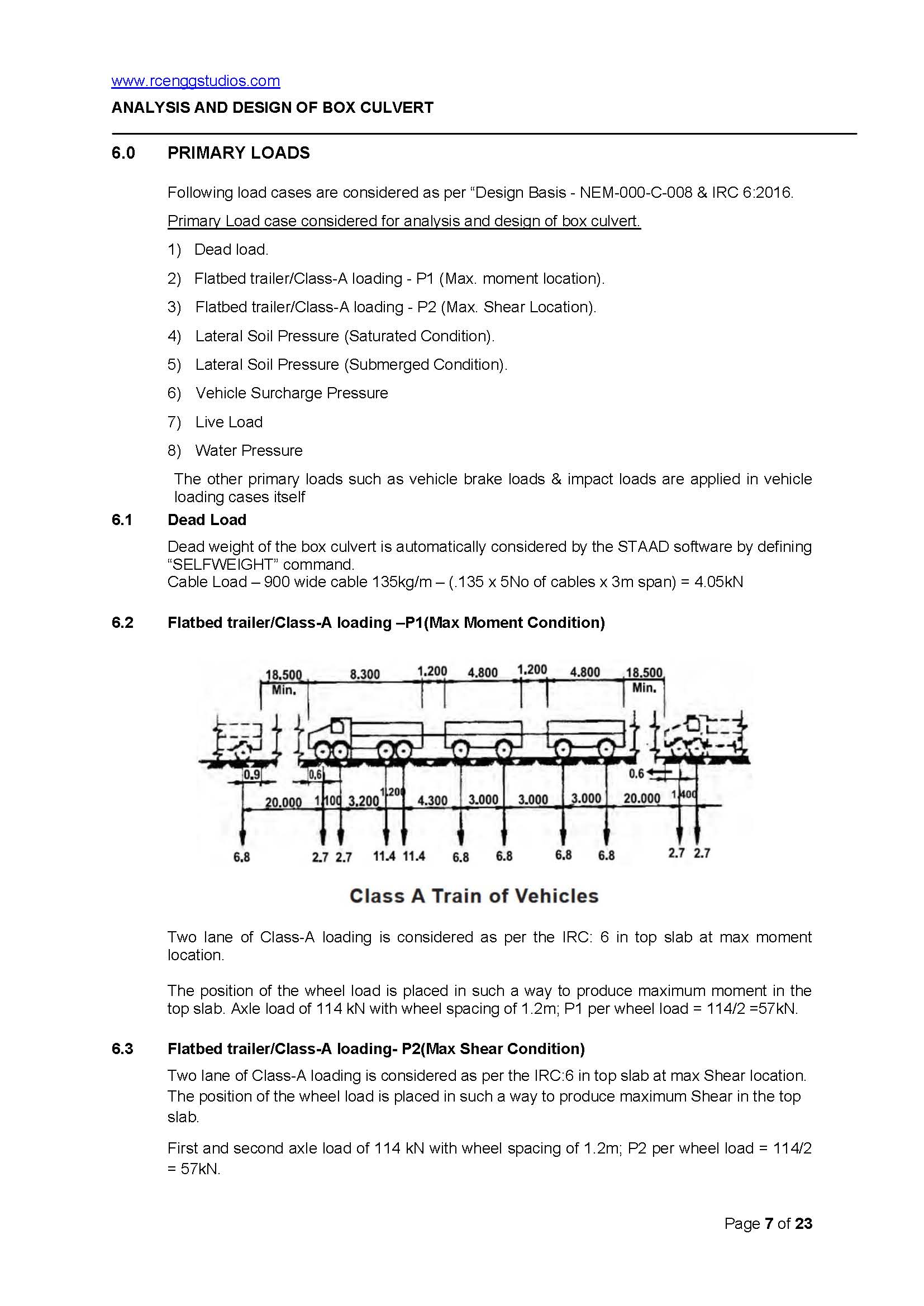Box culvert design according to IRC 6 (Standard Specifications and Code of Practice for Road Bridges, Section II) involves several considerations for structural strength, stability, and durability. Here are the main design bases to consider:
1. Load Considerations
- Dead Load: Weight of the box culvert, including the self-weight of the concrete, parapets, and other permanent structural components.
- Live Load: Vehicular load as per IRC 6, generally adopting IRC Class A, AA, or 70R loading, depending on the culvert’s location and importance.
- Impact Load: Apply an impact factor as per IRC 6 if vehicles can travel directly over the culvert, based on the design speed and load class.
- Surcharge Load: Lateral earth pressure due to embankment or backfill material on top of the box culvert.
- Water Load: Hydrostatic pressure exerted by water on the culvert, considering maximum water levels and pressure distributions.
- Earth Pressure: Lateral and vertical earth pressure, depending on soil type, compaction, and depth of the cover.
2. Design Parameters
- Effective Span and Depth: Determine based on the roadway width, hydraulic needs, and site conditions.
- Material Strengths:
- Use minimum M25 grade concrete and Fe 500 steel as specified by IRC standards for durability.
- Reinforcement Detailing: Reinforcement should comply with IRC standards for ductility and resilience against loading.
- Clear Cover: Provide a minimum cover as specified by IRC to protect reinforcement from environmental exposure.
3. Hydraulic Design
- Calculate the hydraulic capacity based on IRC SP 13 to ensure the culvert can handle expected water flows.
- Check for scouring and erosion potential and design to mitigate these effects.
4. Structural Design Checks
- Bending Moment and Shear Force: Calculate moments and shear at various sections (e.g., midspan, supports) using the loads and support conditions. Ensure compliance with bending and shear capacities as per IS 456 and IRC standards.
- Serviceability Checks: Check for deflection, cracking, and durability. IRC specifies crack width limits and deflection limits based on service life requirements.
5. Other Considerations
- Thermal Effects: Design for temperature gradients in areas with significant seasonal temperature variations.
- Durability and Service Life: Select materials and design thicknesses to ensure a long service life with minimal maintenance.
- Construction Joints: Place construction joints according to IRC specifications to accommodate differential settlement and thermal movements.
6. Load Combinations
- Apply various load combinations as per IRC, including:
- Dead Load + Live Load
- Dead Load + Surcharge Load + Live Load
- Water Pressure + Dead Load + Live Load
Example Design Considerations:
- For a 2-lane box culvert, with Class AA loading:
- Top Slab: Designed to resist bending moments due to dead load, live load, and surcharge.
- Walls: Designed for both axial and flexural stress due to earth pressure and surcharge.
- Bottom Slab: Resists uplift pressure and bending due to subgrade reaction.
References
- IRC 6-2017: General Specifications for Loads and Stresses
- IRC 21: For the concrete mix and structural detailing requirements.
- IS 456: For concrete design and reinforcement detailing










JOURNAL PAPER GUIDELINES FOR ACSE
Submission Guidelines: ASCE encourages the submission of scholarly and practice-oriented articles to its journals. Before…
SHELTER WITH 25T CRANE DRAWING | PEB SHED |
Designing a shelter with a 25-ton capacity crane involves structural considerations to support the heavy…
kitchen marble design 30+
Here is a modern kitchen design with luxurious marble elements. It showcases a sleek and…
Plumbing Drawing
Creating a plumbing scheme drawing involves outlining the entire plumbing system of a building, showing…
Standard Road Details
Rigid & Flexible Road Details – Drawings & Requirements Road construction is broadly classified into…
Design of Gantry Girder
Designing a crane girder, which is a key structural component used in overhead cranes, involves…







